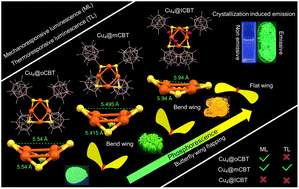Carborane-thiol protected copper nanoclusters: stimuli-responsive materials with tunable phosphorescence†
Abstract
Atomically precise nanomaterials with tunable solid-state luminescence attract global interest. In this work, we present a new class of thermally stable isostructural tetranuclear copper nanoclusters (NCs), shortly Cu4@oCBT, Cu4@mCBT and Cu4@ICBT, protected by nearly isomeric carborane thiols: ortho-carborane-9-thiol, meta-carborane-9-thiol and ortho-carborane 12-iodo 9-thiol, respectively. They have a square planar Cu4 core and a butterfly-shaped Cu4S4 staple, which is appended with four respective carboranes. For Cu4@ICBT, strain generated by the bulky iodine substituents on the carboranes makes the Cu4S4 staple flatter in comparison to other clusters. High-resolution electrospray ionization mass spectrometry (HR ESI-MS) and collision energy-dependent fragmentation, along with other spectroscopic and microscopic studies, confirm their molecular structure. Although none of these clusters show any visible luminescence in solution, bright μs-long phosphorescence is observed in their crystalline forms. The Cu4@oCBT and Cu4@mCBT NCs are green emitting with quantum yields (Φ) of 81 and 59%, respectively, whereas Cu4@ICBT is orange emitting with a Φ of 18%. Density functional theory (DFT) calculations reveal the nature of their respective electronic transitions. The green luminescence of Cu4@oCBT and Cu4@mCBT clusters gets shifted to yellow after mechanical grinding, but it is regenerated after exposure to solvent vapour, whereas the orange emission of Cu4@ICBT is not affected by mechanical grinding. Structurally flattened Cu4@ICBT didn't show mechanoresponsive luminescence in contrast to other clusters, having bent Cu4S4 structures. Cu4@oCBT and Cu4@mCBT are thermally stable up to 400 °C. Cu4@oCBT retained green emission even upon heating to 200 °C under ambient conditions, while Cu4@mCBT changed from green to yellow in the same window. This is the first report on structurally flexible carborane thiol appended Cu4 NCs having stimuli-responsive tunable solid-state phosphorescence.



 Please wait while we load your content...
Please wait while we load your content...